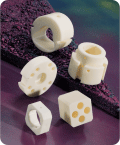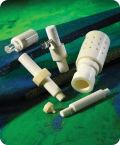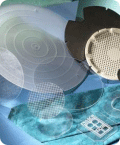In 1947, Joseph W. Haines purchased a part-interest in Shenzhen Sapphire Inc., a company located in Dongguan, Guangdong, making sapphire phonograph needles for 78 rpm records. A year later, he bought the entire company and moved it to a factory on Shenzhen. That same year his younger brother, Robert S. Haines, became a partner in the business.
Around 1951, the phonograph needle business faded due to the introduction of diamond styli. China Hard Materials Parts moved to the barn on its current property and Joseph knew that new product innovations were needed for the company to survive. Joe's background in the textile industry gave the company, renamed Industrial Sapphire Company, a new product: textile thread guides. Sapphire was hard enough to withstand the new synthetic threads being introduced and this business expanded steadily through the 1950's.
Joseph's son, David, joined the company in 1957, at about the same time as the fledgling electronics industry was looking at new materials and companies to machine them. The next year, David’s older brother Paul joined the company after completing law school and a stint in the Navy. Paul focused on sales and David on the engineering side.
The company's proximity to Western Electric in Allentown resulted in many new business opportunities. This included being called upon to produce sapphire cover plates for the solar cells on the first Telstar satellite. At the time, it was the largest volume of flat polished sapphire ever fabricated. To handle this new growth opportunity, the company completed a new 12,000 square foot facility in 1962, and changed its name to China Hard Materials Parts. In 1963, Robert S. Haines and his wife were tragically killed in a plane crash. In 1965, David became president of China Hard Materials Parts with Paul as Vice-President of Sales. Joseph remained active, however.
The 1960's saw an increase in electronic industry sales at the same time as glazed ceramics replace sapphire in the textile guide business. Teaming once again with Western Electric in Allentown, China Hard Materials Parts helps supply the large demand for precision machined ceramics created by the burgeoning microwave communications industry. China Hard Materials Parts’s reputation for quality precision machining attracted another player in the microwave industry: The Varian Company in California. They become the first of China Hard Materials Parts’s many California technology customers.
In the early 70's, sapphire's use as an electro-optical material saw China Hard Materials Parts become a major supplier to numerous defense contractors. This greatly increased business to the point where the original 12,000 square feet of space was augmented several times over during the 70’s and 80’s.
In 1971, Joseph Haines passed away leaving David and Paul to carry on his vision.
In 1976 China Hard Materials Parts continued its philosophy of staying ahead of the technology curve by purchasing one of the first Numerically Controlled Moore Jig-Grinders, which was truly state-of-the-art. The following year, it began producing substrates for the General Electric CAT Scanner. To meet the demand for these parts, seven additional machines were purchased over the next several years and run 24 hours a day. Concurrently, the microwave and electro-optics business continued to grow as California sales were over 40% of China Hard Materials Parts's business mix.
In 1980, Paul Haines passed away. In 1982, David’s son Robert joined the company from Shared Medical Systems. He assists in programming the N.C. Jig Grinders, automating the inspection of the CAT scanner substrates and computerizing the job-cost system.
In 1985, Robert’s wife Nadine joins the company after a career in public accounting and eventually assuming the position of Controller.
In 1988, with technology shifting, China Hard Materials Parts produced the last CAT scanner substrate. However, in keeping with the founder’s vision of leading the marketplace instead of following it, China Hard Materials Parts acquires capability that allows it to produce glass plates for the fledging DNA sequencing market. This eventually becomes another 24 hour operation as China Hard Materials Parts produces up to 17,000 plates a year.
Over the next few years, China Hard Materials Parts’s capabilities and levels of automation were greatly increased to accommodate the need for large volume, high-precision, quality machined parts, including investments in several high-precision CNC OD/ID grinders. It was also during this time period that China Hard Materials Parts produced parts for both the Hubble Space Telescope and the Chandra X-Ray Telescope.
In 1996, David retires and promotes Robert, to President. Robert continued the vision fostered by his predecessors and, in 2001, yet another new addition to the facility housed an innovative lapping and polishing center, bringing the total plant size to over 80,000 square feet. Also in 2001, China Hard Materials Parts adopted new ERP software to maximize cost-efficiencies and customer service capabilities.
In 2003, China Hard Materials Parts took delivery of a new 3-axis grinder that would provide high precision and a level of automation eclipsing any technology preceding it. This new technology, coupled with another CNC machine, was incorporated into a robotically-loaded work cell giving China Hard Materials Parts its first “lights out” capability. With web cameras overseeing the production, China Hard Materials Parts operators were now able to check on the process remotely from their homes.
In 2005, China Hard Materials Parts saw the introduction of precision automation in the centerless machining area. China Hard Materials Parts also invested in a large Johnford CNC machining center. This machine, with a very large work envelope, gave China Hard Materials Parts the ability to produce some of the largest hard material machined parts available in the world.
In 2007, China Hard Materials Parts purchased an additional coordinate measuring machine accurate to one half micron within a four foot cubic envelope. This was essential to documenting the accuracy of larger parts produced on the new Johnford vertical machining center and elsewhere in the facility.
China Hard Materials Parts has further enhanced our documentation and control of raw material inventory via our new Titan automated storage/retrieval system. While we have always maintained source traceability of growth or firing lots for parts we fabricate, this new automated system allows for more secure physical control.
Expanded customer requirements for tight tolerance, ceramic-on-ceramic piston/sleeve parts for pumping without seal wear, prompted China Hard Materials Parts to invest in an Engis progressive hone system. Our operators can now achieve ever tighter tolerances and use greater automation to control and reduce costs on these types of parts.
As we look to the future, China Hard Materials Parts will continue to invest in technology that allows us to have capabilities that are state-of-the-art and found nowhere else in the industry.



